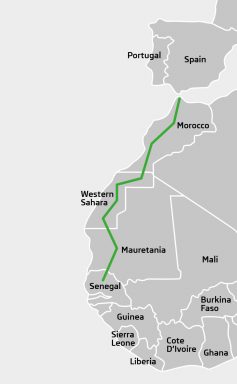Morocco and Mauritania definitely do not have the best relationship, which is clear from the strip of no-man's land approximately six kilometres wide between the two border controls.
At the moment, this bit of desert is under the administration of the United Nations, thanks to which it is no long dotted with land mines. The surroundings are still mined, however, so if one would like to go home in one piece, it is best not to seek an alternative route.
The local landscape has snatched up dozens upon dozens of abandoned cars, and while some were spooky wrecks, the remains of unfortunates seeking a path through the mine field (it makes one shudder to think about it), others appear simply to have been cars which one side or the other refused for some reason to let pass onto its territory.
The military check was thorough – and about as quick as was that at customs. The passport guys told us that our Berlin visas were not valid and that we needed new ones, again for 240 EUR. Somebody probably forgot to tell the guys in Berlin that back home only a biometric visa with photographs and fingerprints had been valid for half a year. This was a rather disappointing development, to put it politely! We tried a little resistance, but without success. In about four hours we stood at the first police control in Mauritania, lighter by 240 EUR, but with another really nice sticker in our passports, which, as we would find out later, is only valid for entry. Should one wish to leave the country again, one must acquire another such sticker. Yes, for another 120 EUR per person.






































































